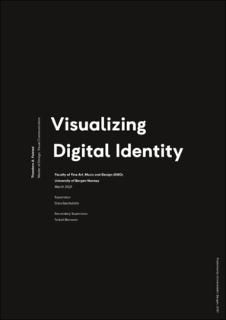| dc.description.abstract | We cannot see what our digital identity looks like or view what it says about our behavior, feelings, or actions that are stored online. The data that is collected by surveillance from our smartphones build a fragmented and distorted reflection of ourselves. This stockpile of our data and this mirrored self it creates have become an increasingly valuable commodity that fuels the surveillance economy. While the existence of these datasets is not always obvious, they are attainable by request while the reflection of yourself they create is a heavily guarded secret. The digital identity created by this collection of data is explored through visual communication design. Datasets were acquired by applications such as Google, Spotify and Instagram from my smartphone. With this information I explore if design methodology can be applied to create a representation of my digital identity, and what critical reflections can these representations reveal about my digital identity? New processes were explored by using researching through design. In this process, the disconnections between concepts contained within the topic of digital surveillance and digital identity are analyzed. The scope of the project and the visualizations move through cycles of simplification as they narrow towards a place where a reflection can be made. These visualizations use Methodology from Surrealism and Discursive Design in their process and reflection. This recounts my research through design, and explores visualization of digital identity through using design as a medium for understanding. The visualizations move in a timeline through a series of iterative explorations. Each iteration contains its own context, process, and reflection. The iterative exploration moves towards understanding the digital identity by approaching the subject from multiple perspectives and executions of design. A theme of a distorted and fragmented reflection appears as the visualizations evolve in their process of iteration. The resulting understanding of a digital identity may never be finalized, but the resulting discourse invited through exploration becomes subjective reflections. This understanding of our fragmented and distorted reflections of our digital identity opens possibilities for further research. | en_US |
